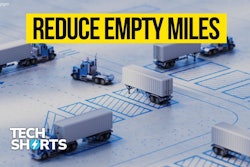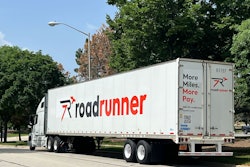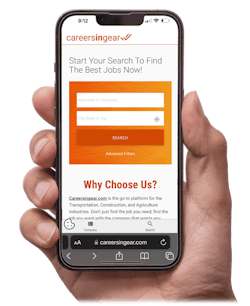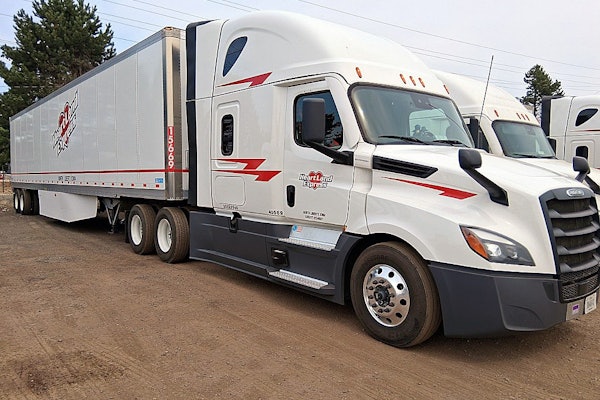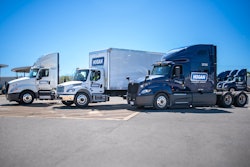Trucking companies, shippers and brokers all have the same ultimate goal – get freight to its destination, when it needs to be there, safely. But often those different entities operate in their own separate systems, which impacts communication, limits visibility, and can create contentious relationships.
Brokerage firm ACI Transport has set out to bridge some of those gaps with its CarriedAway platform.
Contents of this video
00:00 10-44 intro
00:38 ACI Transport’s TMS CarriedAway
01:09 Development of their own transportation management system
04:12 How is CarriedAway different from other TMS options?
07:33 Solving a fractured technology landscape
10:08 Improving relationships between brokers and carriers
Matt Cole:
How a brokerage is looking to improve carrier shipper relationships.
Jason Cannon:
Hey everybody. Welcome back. I'm Jason Cannon and my co-host is Matt Cole. Trucking companies, shippers and brokers all have the same ultimate goal, get freight to its destination when it needs to be there. But often those different entities operate in their own separate systems, which impacts communication, limits visibility, and can create contentious relationships.
Matt Cole:
In an attempt to reduce that friction, brokerage firm ACI Transport has created a transportation management system it calls "CarriedAway" to address these challenges.
Gary Horton:
So ACI Transport is a third party logistics brokerage founded in 2015 by myself and two other partners. We're approaching 10 years in business. Primarily, we started out helping out companies with finished vehicle transport, so primarily finished vehicles, whole cars. And then in the last few years we've really taken an increased part of the general freight and commodity space. So moving more variance of things outside of finished vehicles.
Jason Cannon:
After spending some time in the brokerage industry and ultimately starting their own brokerage. The A CI team found that TM TMSs on the market weren't what they were looking for leading to the development of their own system.
Gary Horton:
When we started in business, the main driving factor was we had a brief stint in the brokerage space, me and my partner Aaron Freedman, who's our CEO, and we had worked with some people that had a lot of experience in the industry and we found that the values and purpose that they were working with didn't really align with our own. And we felt that that was somewhat pervasive in the industry, especially in third party logistics, which tends to be a little bit more shadowy and obfuscated. And so we started ACI Transport with the main goal of providing great services through the lens of our core values, which are adaptability, communication, and integrity. And so when we initially came into the market, that was the main thing we were trying to bring to the forefront. We felt very confident that we were able to come to market and compete at that level with any player as far as embodiment of a core message and values.
We do that through our sort of behavioral uniques on which we list as effective responsiveness, hyper friendly, memorable service and transparency. And so initially that's what we thought we were bringing to the brokerage market. As we attempted to grow pretty quickly in the first couple of years, we found it needed a better way of organizing the work and communicating to the different parties in the chain. So whether that be shippers who had things to move, carriers who we were contracting with to move them, consignments that were involved being picked up from and dropped off to. And we needed a better way to organize that information. We initially started with a small single purveyor who has had their own homegrown transportation management system, and we worked with them for a couple of years in our early time and it was a really great experience. But we did challenge the system often with the way we wanted to do things and the way we wanted to communicate and exemplify our values in our work.
And so in 2019, that is when we in earnest started to transition to our own system. We brought on a fourth partner, our CIO, Nathan Sriro, who helped us develop the TMS starting in June of 2018, and we went live on that as a company in 2019. The main reason we wanted to transition to our own transportation management system called CarriedAway was so that we could more fully control the experience of people that were working with ACI Transport. And the portals and technology that you work in is highly impactful to the experience of your customers, colleagues, partners, etc. And so really that was our main drive of starting our own was we wanted to have full control over the experience that our partners were having. And that's from our employees through to our customers.
Matt Cole:
So what does CarriedAway do and how does it differ from other TMS options?
Gary Horton:
Primarily what it provides for our shippers and our carriers is insight into the current state of transports, whether they be assigned to you as a carrier or assigned to us from a customer. And the idea is to increase visibility, hence our transparency. So we offer shipper portals, ways of viewing the data alerting system from emails and notifications internally. Same thing on the carrier side. A lot of access into the work that we have and an ability to request that work, add interest, do things like electronic bills of lading. Again, primarily girding the communication and clarity of the work that we're doing. So shippers are going to be primarily working in the system by either assigning us units through it and then doing their own sort of research and follow up and tracking of their own shipments. And on the carrier side, they're mostly interacting with our load board to request work and then using our carrier logistics app to perform on the ground inspections and communicate transport status.
Those are the two ways that those parties tend to interact with carried away the real, I would say, innovation of carried away or what we have found to be comparatively different both from our customer and carriers experience and then our own working with other companies is a couple of things. The system is designed for multimodal transport, which is just saying what, however something is being shipped. The system allows for you to communicate, record and report on relevant details to that type of shipment. Many other transportation management systems do not necessarily handle finished vehicles and general commodity freight in a explicitly guided way. And that was something because we started out in the niche of finished vehicles and expanded into general commodity freight by business requirement, we made a very flexible system. The other thing, and this is I don't necessarily know how it compares to others' architecture.
Our system is built from the ground up in a multi-tenant environment. And all that means to say is that we try to, from a philosophy standpoint, separate the different players in a transport all the way through to consignments third party vendors for things like loading and unloading and tried to build the system in such a way that we could give each of those parties a unique look at the transport. So we do that by building something which effectively says we have a shared universe that all of the players have their own little piece of. So it allows us from a brokerage side to be really flexible in how we communicate with each party and make it contextual to what's important to them. And that has been a little bit different than I think most ecosystems, which tend to be somewhat specific to their own structure and a little bit rigid in how people may or may not interact with that piece of software. And so that would, I say philosophy wise, that's what I've noticed as the biggest difference, and that's without having a ton of direct knowledge of how others may be attacking the technology issues in their own platforms.
Jason Cannon:
One of the biggest challenges that the ACI team saw for both shippers and carriers was having too many different systems that they were trying to work with.
Gary Horton:
I would say the major challenge that, and this is inclusive of customers and carries that they face, is that the technology landscape for transport is fairly fractured. So lots of apps, lots of TMS systems, lots of internal ERPs and inventory management systems that large companies had have developed over years. And I see the main frustration is the ease of and speed of connecting to other external systems and having a clean translation of information between them. And so when you have many players working off of many different legacy systems, some being EDI driven, which is sort of an older integration platform all the way to even modern APIs that may be built differently from platform to platform, we found that a lot of our customers reacted to our ability to translate the information from our system into their system as being the sort of aha moment for them.
I found that carriers often are forced to work in many different shippers applications in order to ease the burden of documentation and communication. However, that can be somewhat disorganized when you have to have 10 different logins and work with a lot of different companies. One of the things that's sort of from a philosophy standpoint important about Carried Away is that we are technology agnostic. The idea is we would like to connect with an GERD and ad support to the systems you are internally using wherever possible. We like to interact with the customer's own ERP and where possible integrate with that so that they can work in one system while still gaining the benefit of the organized information in carried away. So I think the fractured technology nature was one of the bigger things, which in turn led to mistranslations of information, information that is required for good decision making to be obfuscated on the vendor side and not able to pass through to the customer side so that they can make the best choices for when, where, and what to ship. Again, carried away is really looking to make over technology landscapes and not take over technology landscapes, which is a little bit different I think of a philosophy and allows us to be a little bit more flexible in how exactly we connect to whatever systems you're using every day.
Matt Cole:
Relationships between brokers and carriers have been shaky at best in recent years, and Gary explains why he believes that is and how ACI looks to address the problem.
Gary Horton:
Carriers have really taken the brunt, I would say, of the transitions in the market. A lot of the changes that are being forced top down from a consolidation standpoint, right, a consolidation of shippers, a consolidation of brokers has really forced a lot of changes onto them that have led to what I think anecdotally, and I think there might even be some data to back this up, but anecdotally has really led to a pressure on the quality of the transport process. And there needs to be a true and honest understanding from the broker side that at the end of the day, we are here as a broker to insert ourselves into a situation where we are not necessarily the principal actors, we're not necessarily shipper, we're not necessarily the carrier. And add value broker was a four letter negative word for a long time because a lot of brokers concentrate on extracting value from the situation, meaning there's a valuable transaction happening between shipper and carrier and the broker wants to come in and get their piece.
And I think our attitude, it is understandable that there would be a tension between brokers and carriers because when you're extracting value, it has to come from somewhere and it's just oftentimes, I would say culturally, it was easier to put that on the carriers, which is part of the problem. We really try and say, Hey, look, if we're entering a situation as a broker, we should be improving outcomes. We should be improving communication between the shipper and the carrier. We should be easing the burden of both. Therefore, not just extracting value but creating it. And I think when you create value in a situation, especially for the carrier, they feel that and respect that, and I think that's important for the brokers to understand too, if you need to be creating value, not just for your shipper, but also for your carrier if you're doing it the right way.
Jason Cannon:
That's it for this week's 10 -4. You can read more on ccjdigital.com. While you're there, sign up for our newsletter and stay up to date on the latest in trucking industry news and trends. If you have any questions or feedback, please let us know in the comments below. Don't forget to subscribe and hit the bell for notifications so you can catch us again next week.



